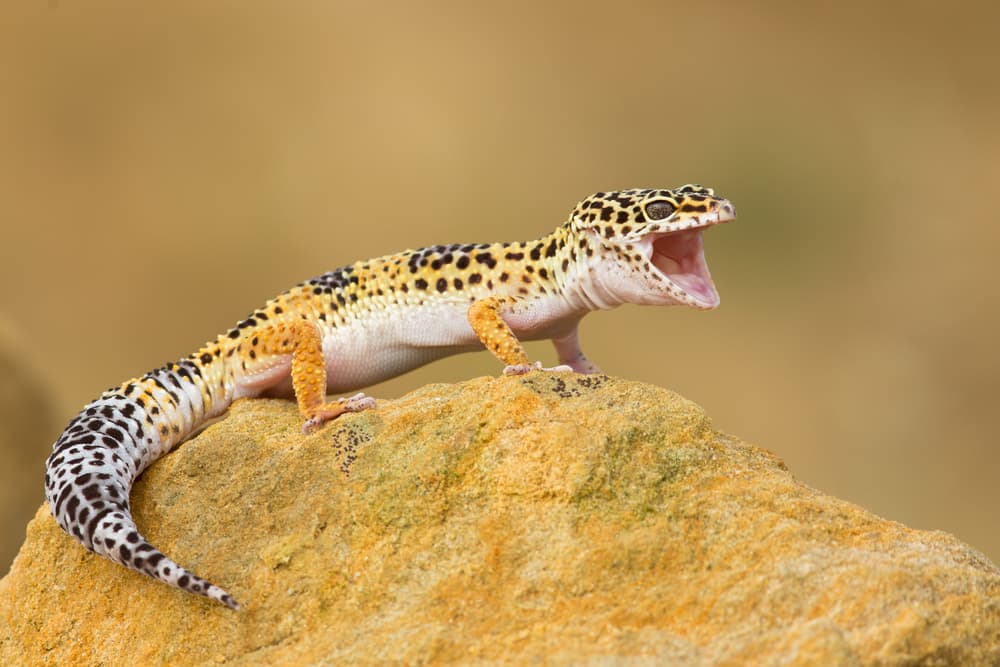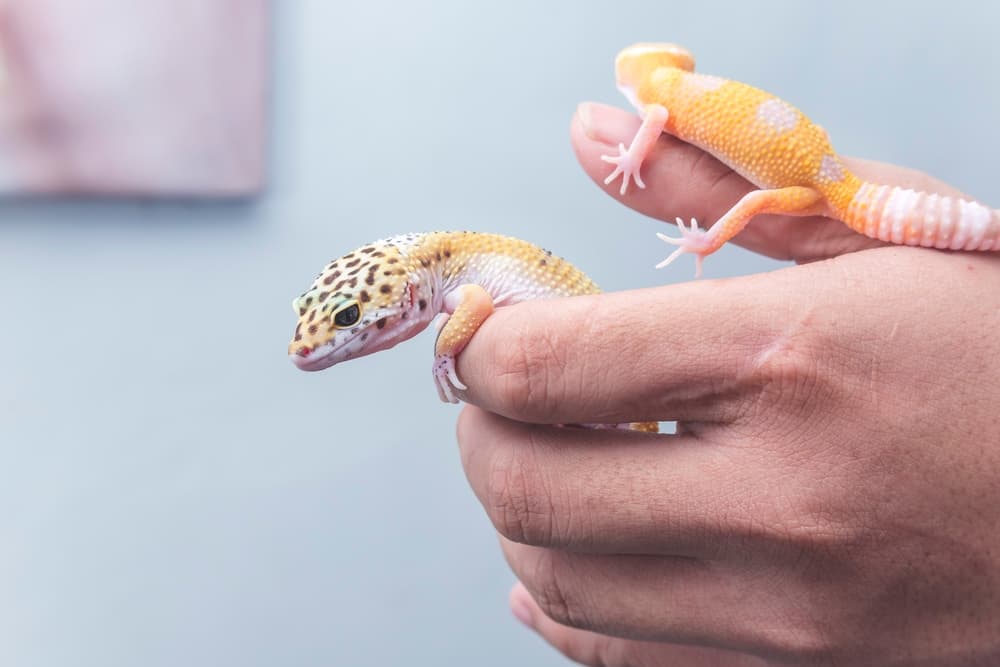
Leopard geckos (Eublepharis Macularius) are fascinating animals as pets and in their wild habitat. They are a popular choice for reptile enthusiasts and make excellent pets due to their hardiness. But how long do they live?
Whether you take pride in being a leopard gecko owner, have plans to adopt one, or find this unique species captivating, it’s natural to be curious about their lifespan. Let’s delve into the average lifespan of a leopard gecko and discover how big they grow!
How Big Do Leopard Geckos Get?
Fully grown leopard geckos typically measure around 8 to 10 inches, with males slightly surpassing females in size. Generally, males are larger than females by an inch or two. However, their dimensions and overall shape remain quite similar.
How Long Do Leopard Geckos Live as Pets?
 Leopard geckos originate from the Middle East’s semi-arid, sun-drenched, mountainous deserts. Specifically, they inhabit Iran, India, Pakistan, and Afghanistan regions. One of the reasons these reptiles thrive and require minimal care in captivity is their exceptional adaptation to the challenging environments of their natural habitats.
Leopard geckos originate from the Middle East’s semi-arid, sun-drenched, mountainous deserts. Specifically, they inhabit Iran, India, Pakistan, and Afghanistan regions. One of the reasons these reptiles thrive and require minimal care in captivity is their exceptional adaptation to the challenging environments of their natural habitats.
Pet geckos generally thrive in captivity compared to their wild counterparts. On average, they have a lifespan of 10 to 20 years. Interestingly, female geckos in captivity tend to have slightly shorter lifespans than males.
This is because they sometimes lay infertile eggs, even without mating with a male. The repeated stress of egg-laying takes a toll on their bodies, shortening their lifespans.
Factors that Affect a Leopard Gecko’s Lifespan
Leopard geckos in captivity enjoy longer lifespans than their wild counterparts due to many influencing factors. Let’s explore some of these factors:
- Except for rare occurrences such as attacks from cats or dogs, they roam without fear of predators.
- You’ll be pleased to know that they carry much lower rates of parasites! They mainly feast on insects bred and raised in captivity before being sold to pet shops and other retailers.
- Lower rates of illness and disease, largely thanks to improved sanitary measures and closely regulated conditions.
- Should illness occur, exotic veterinary care is becoming more widely available, and easier to access.
- Overall, they have lower rates of stress compared to wild leopard geckos.
Pet geckos can have longer lifespans primarily because they reside in controlled enclosures. Ideally, temperature, humidity, and diet are closely monitored, and promptly adjusted at the indication of abnormalities. If a captive gecko falls ill or sustains an injury, their owner is able to find proper vet care.
Leopard Gecko Care Level
 Leopard geckos are amazing! They’re incredibly hardy and can easily get used to being handled, although baby geckos can be a bit jumpy. The best part is that cleaning is a breeze since leopard geckos tend to only do their business in one spot.
Leopard geckos are amazing! They’re incredibly hardy and can easily get used to being handled, although baby geckos can be a bit jumpy. The best part is that cleaning is a breeze since leopard geckos tend to only do their business in one spot.
Remember to give your new leopard gecko at least a week to settle into its new home before handling, starting with just a few minutes at first. And please, never pick them up or hold them by their tails, as they can drop them if stressed.
Some things to take into consideration to properly care for your gecko are:
Temperature, Lighting, and Space Requirements
To keep your leopard gecko comfy, make sure its tank has a hot spot of around 90-95 degrees. You can achieve this by placing a heat pad on a thermostat under part of the bottom, however above heat (CHE, DHP, basking spot) is ideal as it mimics the sun. The ambient tank temperatures should stay around 80 degrees and not drop below 70 degrees.
For the little ones, a 20-gallon tank is perfect, while adults thrive in 40-50-gallon tanks. Remember, length and width are usually more important than height, though given the opportunity they will climb on sticks and decor. Leopard geckos are SOLITARY and should not be housed together except for breeding purposes.
Humidity/Water Requirements
To maintain optimal tank humidity levels, it is recommended to keep them around 30-40%. Ensure a water bowl treated with repti-safe is present in the cage, and to keep it clean and free of debris and biofilm.
Cage Flooring
Leopard geckos need a dry substrate, and there are several easily cleanable options to choose from. Paper towel, tile, non-adhesive shelf liner, and newspaper are all good options for non loose substrates. We recommend a mix of playsand and organic topsoil for loose substrates, as if ingested it can be passed easily. Avoid repti-carpet, as their teeth and nails can get caught, and rip out.
Cage Decoration
Leopard geckos need at least three hides in their enclosure: one with moisture on the warm side, a dry warm hide, and another without moisture on the cooler side. The moist hide can be created by lining it with dampened moss or a wet paper towel. Though three hides is minimum, these curious reptiles love cluttered and enriching environments, there is no maximum enrichment! Feel free to add lots of foliage, climbing opportunities, and new decor!
Jabberwock Reptiles Have You Covered!
Leopard geckos can make wonderful pets due to their hardiness and long lifespans. They live 10 to 20 years in captivity, with optimal care and maintenance. Their lifespan can be extended further by living in carefully controlled enclosures, accessing quality food sources, and receiving veterinary attention when needed.
At Jabberwock Reptiles, we sell an impressive selection of exotic reptiles as well as products for their care. We have a wide variety of leopard geckos ranging in size and color. All our animals are healthy and well-taken care of to ensure their long lifespans!
Our knowledgeable staff is always happy to answer any questions about caring for a pet reptile. Visit us today and discover the wonder of owning a pet reptile yourself!
